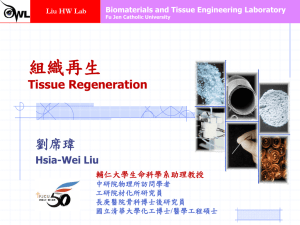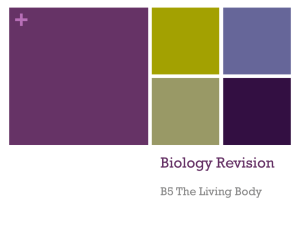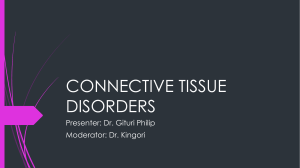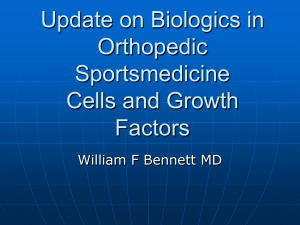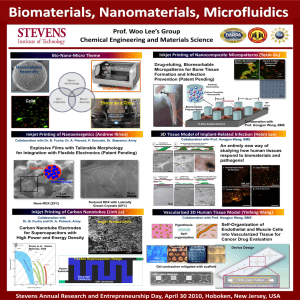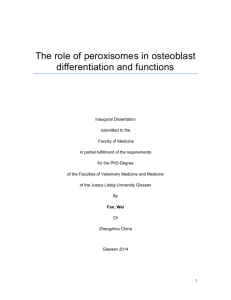PowerPoint 簡報
advertisement
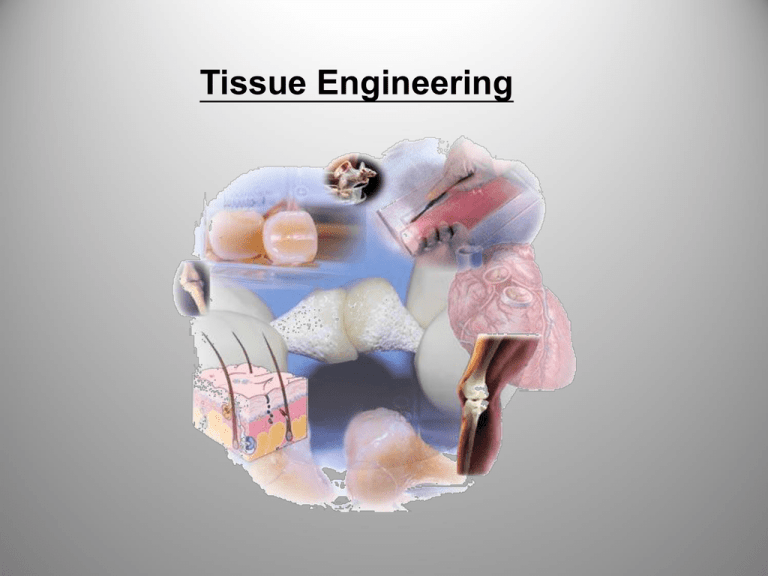
Tissue Engineering Mouse Ears http://www.youtube.com/watch?v=PEc7QXAjsL4&feature=related 1997 MIT Engineering Tissue http://www.youtube.com/watch?v=WvSxZ4JKQAY&feature=related Corneal Tissue Engineering Blood vessel tissue engineering Liver tissue engineering Cartilage tissue engineering Bone tissue engineering Key Factors involving tissue engineering Scaffold( ceramics collagen, polymers) Interactive traids of responsive cells Cell Culture( stem cell, osteoblast, chondrocyte, hepatocyte Signaling Molecules (Growth Factors, proteins Supportive matrix Bioactive molecules promoting differentiation and regeneration Tissue/Organ regeneration Application of tissue engineering Transplantation Cellular and tissue bases product Alternative to animal test 3D culture Developing procedures used in cartilage tissue engineering 1st generation Principle approach Autologous cell transplant Important component Periosteal flaps( 修補 組織 骨骼) 2nd generation Performed tissue flaps 3D construct Delivery substances and scaffold( 體內重新 建構) 3rd generation In vivo regeneration and guided tissue repair Growth factors and biomaterials(體內再 生) Cartilage Tissue Engineering I. Autologous chondrocyte 1. Isolation of tissue sample from patients 2. Tissue regeneration by precursor cells or embryonic stem cells articular cartilage repair, nasal septal cartilage scaffolds for cartilage for tissue repair ECM ( Extra cellular Matrix) ECM interaction directly influence cell signaling via cell adhesion molecules such as integrin and cadhedrin, fibronectin, collagen, laminin…. Extracellular Matrix in relation to epithelium endothelium and connective tissue Epithelial cell Basement membrane Endothelial lining the capillary Connective tissue with interatitial matrix Fibroblast Steering Stem Cell Differentiation Differentiation of stem cells induced by binding to extracellular matrix components (e.g. proteins such as fibronectin, collagen and laminin)components http://inano.au.dk/organization/research-groups/nanobiointerfaces/research/steering-stem-cell-differentiation/ II. Scaffold for tissue construction 1. Act as shape and guidance template for in vitro and in vivo tissue development 2. Permit 3D immobilization and maintain differentiation materials: hyaluronic acid, collagen, alginate, chutosan, synthetic biodegradable poly( hydroxy ester) polyacetic acid,( PLIA), polyglycolic acid( PGA), PLGA…… Embedding medium ( hydrogel) Chondrocyte or Mesenchyma stem cell Polymer fiber Biosynthetic scaffolds Collagen scafold Tissue scafold Cells and + Growth factors In vivo transplant Engineering Organs from Scratch http://www.youtube.com/watch?v=0QJh0yc2mAI&feature=related Tissue in cardiovascular structure Advantages: 1. Avoid repeat operation 2. No rejection by the patients immune system 3. Cells behave like endothelial cells may have low thrombus formation and low infection i.e. valves, blood vessels, vascular patches Basic steps in tissue engineering of a cardiac valve Bone marrow cells harvest Valve scaffold Cell- scaffold construct Approaches to create a vascular graft Cross linking Exogenous chemicals Cells + tubular scaffold Smooth muscle cells progenitor cells collagen gel/elastin fibrin Extra cellular matrix Biodegradable polymers Mechanical stimulations Endothelial lining Autulogous EC Circulating EPC Allogenic EC Embryonic stem cell In vivo implantation Non-thromgenicity Immune response Remodeling American Journal of Transplantation 2004; 4 (Suppl. 6): 36–42 How to Build a Beating Heart http://channel.nationalgeographic.com/series/explorer/4828/Photos/3671755b e79cd210VgnVCM1000000100007fRCRD#tab-Videos/09347_00 http://channel.nationalgeographic.com/series/explorer/4828/Pho tos/3671755be79cd210VgnVCM1000000100007fRCRD#tabVideos/10008_00 http://channel.nationalgeographic.com/series/explorer/4828/Pho tos/3671755be79cd210VgnVCM1000000100007fRCRD#tabVideos/09346_00 Artificial skin skin substitute Adhere to the substrate, Durable and sufficiently elastic Tolerate some deformation Allow evaporative water loss Provide a microbial barrier Promote homeostasis Easy to use Readily available immediately after injury, and elicit a Regeneration-like response from the wound bed without evoking an inflammatory, foreign-body, or nonself immunologic reaction. Annu. Rev. Med. 2000. 51:231–244 Artificial skin Artificial skin Therapy using Artificial skin MSC (Mesenchyma Stem Cells) Proliferate in cultures Differentiate into multiple mesenchyma lineage ie. correction of genetic disorder of , i.e bone cartilage Preparation of 3-D mesenchyma cells Cell seeding on cotton gauze framed collagen substratum Formation of multilayer mesenchyma cells Physical detachment 3D culture Preparation of 3-D mesenchyma cells Seeding of mesenchyma cells confluent mesenchyma cells Seeding of epithelial cells Coculture of epithelial and mesenchyma cells Detachment of epithelial cells –attached mesenchyma cell sheet Formation of hetero-spheroid Osteoblast Arise from mesenchyma cells( MSC) MSC may be differentiate into osteoblast in vitro Cultured osteoblast may form extracellular matrix in culture Transplantation of cultured bone cells Bone marrow derived osteoblast Cultured bone T. Uemura et al. / Biomaterials 24 (2003) 2277–2286 Transplantation of cultured bone cells Bone marrow derived osteoblast Cultured bone T. Uemura et al. / Biomaterials 24 (2003) 2277–2286 T. Uemura et al. / Biomaterials 24 (2003) 2277–2286 T. Uemura et al. / Biomaterials 24 (2003) 2277–2286 Elastomeric PGS Scaffolds in Arterial Tissue Engineering http://www.jove.com/details.php?id=2691 Tissue Engineering -- Building Body Parts http://www.youtube.com/watch?v=ofiLcTs7_Ys&feature=related
